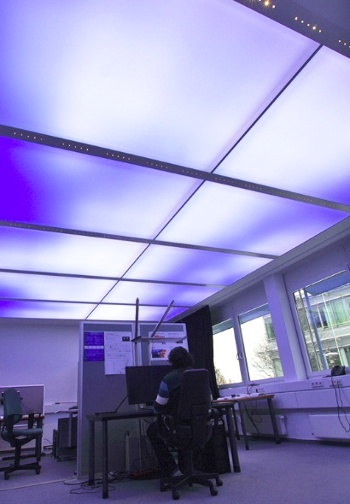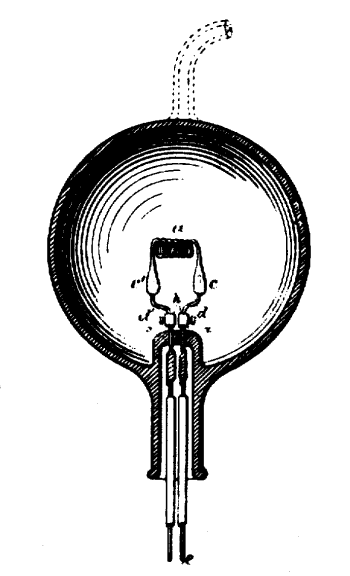Open Office
January 5, 2012
No, this article isn't about the popular (and
free)
computer program that's been my only
office suite for nearly a decade. It's about a
lighting innovation that puts your office under a
skylight, even when it's not located on the top floor of your building. It also ensures that every day is a blue sky day, at least if you're indoors.
This technology seems to be something like the
Star Trek (TNG) holodeck, that
deus ex machina device that's often reviled by
Star Trek fans. After all, Star Trek should be a
space show, not a holodeck rendition of a
Philip Marlowe novel. I'm reminded of similar contortions, such as
Kirk and
Spock as
prohibition era gangsters.[2]
As you've guessed, this skylight is simulated, but its appearance is quite impressive, as the photograph shows.[3]

A nice place to work. This is a far cry from the starkly lighted cubicle environment of most engineers.
The luminous ceiling, developed by the Fraunhofer Institute and LEiDs GmbH, is an array of square tiles, 50 centimeters on a side, each containing 288 light emitting diodes behind a diffusion screen.
(Fraunhofer Institute image, used with permission). [3)]
This lighting innovation was developed by the
Fraunhofer Institute for Industrial Engineering,
Stuttgart, Germany, in collaboration with
LEiDs GmbH. It's somewhat like a giant ceiling
display panel, albeit with lower resolution than your computer display. This ceiling light simulates a blue sky, punctuated with passing
clouds, that's in constant flux. This creates the feeling that you're sitting outside, under an open sky, and not at a desk, with a concomitant beneficial affect on employee mood.[3]
The ceiling display is formed from square tiles, a half
meter on a side, which are just slightly smaller than the standard two
foot square (61 centimeter square) ceiling tiles found in most US office buildings. Each tile contains 288
light emitting diodess (LEDs) behind a
diffusion screen. The light emitting diodes are a color mix of
red,
blue,
green and
white that allows production of more than 16 million colors, the same color range as for a
32-bit computer monitor (16,777,216).[3]
The diffusion filter is placed 30 cm below the LEDs. This filter ensures that the individual LED lights are not seen, but rather a continuous image.[3] Light emitting diodes are more
energy-efficient than most other light sources, so the energy savings over time may pay for the initial investment in this technology. In fact, some of the older, less efficient, light sources are being
outlawed by most governments, so LED lighting of some sort is becoming a viable option.
One essential part of this project was to have scientists study the dynamics of the natural skyscape. They needed to decide what changes and how rapidly these qualities change. Says
Dr. Matthias Bues, head of the
Light Fusion Lab undertaking this research at
Fraunhofer IAO,
"The LEDs allow us to simulate these dynamic changes in lighting in a way that is not directly obvious to the naked eye. Otherwise the lighting might distract people from their work. But it does need to fluctuate enough to promote concentration and heighten alertness."[3]
A prototype ceiling, thirty-four meters square, was constructed with a total of 34,560 LEDs. The light intensity at full power was more than 3,000
lux, but a range of 500-1,000 lux would suffice for most office lighting. This lighting concept was tested with ten subjects who were presented with different lighting dynamics on each of three days. On the first day, the lighting was static; on the second day, there were gentle changes; and on the third day, the changes were rapid. Eighty percent of the subjects (eight out of ten) preferred the rapid dynamics.[3]
This lighting concept will be demonstrated at
CeBIT, a trade fair for digital technologies, in
Hannover, Germany, on March 6 -10, 2012. The lighting system presently costs about 1,000
euros ($1,300) per square meter, but there would be lower prices from
economies of scale once production is ramped up.[3] A two-foot square
fluorescent panel, like the ones in my cellar family room, cost about $50 each, or about $125 per square meter.

140 years, and still going strong, although soon to be replaced by more energy-efficient lighting technologies.
Figure 1 of US Patent No. 223,898, "Electric Lamp," by Thomas A. Edison, January 27, 1880.
(Google Patents). [4)]
![]()
References:
- "The Big Goodbye," episode 12 of Star Trek: The Next Generation, Wikipedia.; Episode trailer on YouTube
- "A Piece of the Action," Episode 46 of Star Trek: The Original Series, Wikipedia.
- Sky light sky bright - in the office, Fraunhofer Institute Press Release, January 2, 2012.
- Thomas A. Edison, "Electric Lamp," US Patent No. 223,898, January 27, 1880
Permanent Link to this article
Linked Keywords: Free and open source software; FOSS; computer program; office suite; light fixture; lighting innovation; skylight; Star Trek; The Next Generation; TNG; holodeck; deus ex machina; space; Philip Marlowe; James T. Kirk; Spock; prohibition era; gangster; Fraunhofer Society; Fraunhofer Institute; LEiDs GmbH; centimeter; light emitting diode; diffusion screen; Fraunhofer Institute for Industrial Engineering; Stuttgart, Germany; display panel; cloud; meter; foot; red; blue; green; white; 32-bit color; energy-efficient; phase-out of incandescent light bulbs; Dr. Matthias Bues; Light Fusion Lab; Fraunhofer IAO; lux; CeBIT; Hannover, Germany; euro; economies of scale; fluorescent panel; Google Patents; US Patent No. 223,898.